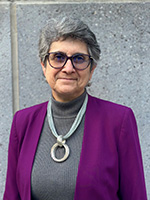Xiadong Cheng, PhD
 Xiaodong Cheng earned his BS in biochemistry from Peking University and MS in biochemistry from Shanghai Institute of Biochemistry, Academia Sinica. He received his Ph.D. in biochemistry from the University of Texas Medical Branch (UTMB). He then
conducted postdoctoral work at the University of California, San Diego, with Professor Susan Taylor, studying the structure and functions of protein kinase A (PKA), a critical cellular effector of the second messenger cyclic AMP (cAMP). Dr. Cheng
started his independent research career in the Department of Pharmacology and Toxicology at UTMB. He is currently the Walter and Mary Mischer Distinguished Professor in Molecular Medicine at the McGovern Medical School, University of Texas Health
Science Center at Houston, where he is a Professor and Vice-Chair of the Department of Integrative Biology.
Xiaodong Cheng earned his BS in biochemistry from Peking University and MS in biochemistry from Shanghai Institute of Biochemistry, Academia Sinica. He received his Ph.D. in biochemistry from the University of Texas Medical Branch (UTMB). He then
conducted postdoctoral work at the University of California, San Diego, with Professor Susan Taylor, studying the structure and functions of protein kinase A (PKA), a critical cellular effector of the second messenger cyclic AMP (cAMP). Dr. Cheng
started his independent research career in the Department of Pharmacology and Toxicology at UTMB. He is currently the Walter and Mary Mischer Distinguished Professor in Molecular Medicine at the McGovern Medical School, University of Texas Health
Science Center at Houston, where he is a Professor and Vice-Chair of the Department of Integrative Biology.
Research in Dr. Cheng’s laboratory focuses on applying multidisciplinary approaches to understand the structure and function of exchange proteins directly activated by cAMP (EPACs). A significant challenge in the cAMP signaling field was the lack
of pharmacological agents specific for EPAC, hindering the understanding of individual biological functions of EPAC and PKA due to their ubiquitous expression and activation by the same signal, cAMP. To overcome this problem, Dr. Cheng developed the
first-in-class EPAC-specific inhibitors (ESIs). This development has been recognized as one of the two major scientific milestones since the discovery of EPAC. These ESIs are invaluable tools for studying cAMP signaling and are widely used by researchers
worldwide. In parallel, using Epac knockout mouse models, Dr. Cheng's group has demonstrated that Epac proteins act as key stress-response molecules and play crucial roles in developing various diseases. Importantly, pharmacological inhibition of
Epac recapitulates the genetic phenotypes of Epac deletion in these disease models, identifying EPAC1 as a potential therapeutic target. Dr. Cheng's drug discovery and translational research efforts resulted in six issued patents and a Sanofi Innovation
Award.
More recently, Dr. Cheng's lab made another important and exciting discovery by demonstrating that cAMP acts through EPAC1 to promote cellular SUMOylation. This finding connects two key stress response pathways for the first time: cAMP signaling and protein
SUMOylation. Importantly, EPAC1-mediated protein SUMOylation is not dependent on its known downstream effectors, Rap1/2 small GTPases. Instead, EPAC1 stimulates cellular SUMOylation through an unconventional mechanism: by promoting the formation of
cellular condensates containing components of the SUMOylation machinery. These results suggest the role of biomolecular condensates in protein SUMOylation and potentially solve a long-term puzzle concerning how few SUMOylation processing enzymes SUMOylate
~7,000 known protein substrates.
Dr. Cheng is passionate about teaching, mentoring, and service. He has been voted as the faculty of the year by students and received the Dean’s Teaching Excellence Award. Dr. Cheng has been a member of ASPET since 2009, serving on the Executive
Committee of ASPET Drug Discovery and Development Division since 2020, and as the Chair of this division currently. He was an Editorial Board member of Molecular Pharmacology from 2014 to 2019. Dr. Cheng is a Fellow of the American Association for
the Advancement of Sciences.
Janet E. Clark, PhD
 Janet Clark is the Director of the NIMH Intramural Research Program (IRP) Office of Fellowship Training (OFT) at NIH. As the Director of the NIMH OFT, she is responsible for the development and oversight of the IRP's integrated multidisciplinary
training program and with providing support and resources for all training-related activities for its nearly 300 trainees. In addition, she serves as the Founding Director of the NIMH IRP Translational Neuropsychopharmacology Initiative which was
created to help re-invigorate psychiatric drug discovery through de-risking and supporting the discovery and development of novel treatments in the IRP.
Janet Clark is the Director of the NIMH Intramural Research Program (IRP) Office of Fellowship Training (OFT) at NIH. As the Director of the NIMH OFT, she is responsible for the development and oversight of the IRP's integrated multidisciplinary
training program and with providing support and resources for all training-related activities for its nearly 300 trainees. In addition, she serves as the Founding Director of the NIMH IRP Translational Neuropsychopharmacology Initiative which was
created to help re-invigorate psychiatric drug discovery through de-risking and supporting the discovery and development of novel treatments in the IRP.
Prior to joining the NIMH IRP, Dr. Clark was Associate Professor in the Department of Pharmacology and Physiology, Director of the Pharmacology and Physiology Graduate Program and Co-Director of the Drug Discovery and Development Program at Drexel University
College of Medicine (DUCOM). Work in her laboratory at Drexel focused on understanding the role(s) of inflammation in the development of mood disorders. In addition to research, she developed and directed graduate course curriculum and developed career
and professional development opportunities for graduate and postdoctoral trainees. Dr. Clark went to Drexel with ten years of research experience from her time at Merck Research Laboratories in the disease areas of neuroendocrinology, psychiatry and
neurodegenerative diseases.
Dr. Clark has had the pleasure of mentoring summer interns, postbaccalaureate, graduate, postdoctoral and clinical scientists over the past 25 years. At NIMH, Dr. Clark has been committed to providing a tool kit of resources for the NIMH early career
scientists that complements their scientific development and prepares them for a successful transition to their chosen professional careers. Dr. Clark’s unique experience in pharma, academia and government has allowed her to help young scientists
consider all of their options when deciding on their next career steps. Pharmacology has played a major role in all parts of Dr. Clark’s career, and she is dedicated to relaying the importance and broad application of training in pharmacology
to new generations of scientists in order to increase interest in the field and in ASPET. An ASPET member since 1998, she has served as Chair of the ASPET Mentoring and Career Development (MCD) Committee since 2019, as Mentor (2017-2020) and now Co-Leader
(2020 to present) of the ASPET Mentoring Network, and as a member of the ASPET Awards Committee (2021 to present).
In addition to her professional experience in mentoring, career and professional development she is a mentor for the Society for Neuroscience (SfN) Neuroscience Scholars Program (NSP) and has served on the NSP selection committee since 2015. She is currently
a member of the American College of Neuropsychopharmacology (ACNP) Education and Training Committee (2020 to present), a mentor in the ACNP URM Near Peer Mentoring Program and was recently appointed as a member of the ACNP URM Near Peer Mentoring
Program Task Force.
Lynette C. Daws, PhD
 Lynette Daws obtained her PhD from the Flinders University of South Australia, in Adelaide, Australia. She currently holds the Frost Bank Distinguished Professorship in Biomedical Sciences, in the Departments of Cellular and Integrative Physiology,
and Pharmacology, at the University of Texas Health Science Center at San Antonio (UTHSCSA). She is also Director of the Physiology and Pharmacology discipline in the Integrated Biomedical Sciences Graduate Program at UTHSCSA. Her research focuses
primarily on biogenic amine transporters, and how they are involved in psychiatric and substance use disorders. Harnessing the combined power of in vivo electrochemical, biochemical, behavioral, pharmacological, and genetic approaches, her groundbreaking
studies have revealed organic cation transporters (OCTs), particularly OCT3, as crucial regulators of biogenic amine signaling. These transporters have low affinity for biogenic amines but a very high capacity to transport them. She found that OCT3
buffers the ability of selective serotonin reuptake inhibitors (SSRIs) to increase extracellular serotonin and produce antidepressant-like effects, providing a mechanism underlying the lack of therapeutic efficacy of SSRIs in so many patients.
Lynette Daws obtained her PhD from the Flinders University of South Australia, in Adelaide, Australia. She currently holds the Frost Bank Distinguished Professorship in Biomedical Sciences, in the Departments of Cellular and Integrative Physiology,
and Pharmacology, at the University of Texas Health Science Center at San Antonio (UTHSCSA). She is also Director of the Physiology and Pharmacology discipline in the Integrated Biomedical Sciences Graduate Program at UTHSCSA. Her research focuses
primarily on biogenic amine transporters, and how they are involved in psychiatric and substance use disorders. Harnessing the combined power of in vivo electrochemical, biochemical, behavioral, pharmacological, and genetic approaches, her groundbreaking
studies have revealed organic cation transporters (OCTs), particularly OCT3, as crucial regulators of biogenic amine signaling. These transporters have low affinity for biogenic amines but a very high capacity to transport them. She found that OCT3
buffers the ability of selective serotonin reuptake inhibitors (SSRIs) to increase extracellular serotonin and produce antidepressant-like effects, providing a mechanism underlying the lack of therapeutic efficacy of SSRIs in so many patients.
In collaboration with Dr. Harald Sitte and colleagues at the University of Vienna, Austria, Dr. Daws found that the actions of amphetamine to cause dopamine release and produce rewarding and locomotor stimulant effects are highly OCT3-dependent. Her ongoing
studies provide a mechanistic basis for why these actions of amphetamine are not lost in dopamine transporter (DAT) knockout mice, which was considered surprising at the time since DAT was thought to be the primary target of amphetamine. Most recently
Dr. Daws has found that ethanol acts at OCT3 to inhibit monoamine clearance. Through this mechanism, ethanol potentiates the ability of cocaine (a DAT, NET and SERT blocker) to inhibit monoamine uptake and produce rewarding effects. Her exciting
research indicates that OCT3 is a promising target for therapeutic intervention in a number of psychiatric and substance use disorders.
Dr. Daws has published over 100 research articles, reviews, book chapters and editorials, and given more than 80 invited talks including the Irvin Page Plenary Lecture at this year’s International Society for Serotonin Research. She has been continuously
funded by the National Institutes of Health, as well as private foundations, throughout her career. She was the recipient of two NARSAD Young Investigator Awards and two NARSAD Independent Investigator Awards. She has trained many students and post-doctoral
fellows who have gone onto successful careers, and who have been the recipients of numerous awards during their training in the Daws Lab. She has served on many national and international scientific review panels. Dr. Daws has been guest editor of
special issues for a number of journals, as well as edited a volume of the Handbook of Experimental Pharmacology on organic cation transporters in the central nervous system. She is a Fellow of the American College of Neuropsychopharmacology. She
served as President of the ISSR. She was co-founder of the International Transmembrane Transporter Society and served as President. Dr. Daws has been dedicated to ASPET for more than 20 years, serving on numerous ASPET committees including Chairing
the Neuropharmacology Division, the Programming and Awards committees. This year she was awarded ASPET’s David Lehr Research Award. She is currently a member of ASPET’s Publications Committee and Editor-in-Chief of Pharmacological Reviews.
Ted M. Dawson, MD, PhD
 Ted Dawson received his BS degree in Premedicine from Montana State University and his medical degree and Ph.D. in pharmacology from the University of Utah School of Medicine. He then completed an internship in medicine at the University of Utah
Affiliated Hospitals before going to the Hospital of the University of Pennsylvania for a neurology residency. Next, he came to the Johns Hopkins University School of Medicine where he completed a fellowship in neuroscience and a senior clinical
fellowship in movement disorders. He joined the Departments of Neurology and Neuroscience in 1994 and became Professor in 2000. From 1996 to 2010 he was director of the Parkinson’s Disease and Movement Disorder Center. He founded the Neuroregeneration
Program in the Institute for Cell Engineering in 2002 and became the Scientific Director of the Institute for Cell Engineering in 2010 and its Executive Director in 2011. He is currently the Leonard and Madlyn Abramson Professor in Neurodegenerative
Diseases and Director of the Institute for Cell Engineering and a professor in the Departments of Neurology, Neuroscience, Pharmacology and Molecular Sciences.
Ted Dawson received his BS degree in Premedicine from Montana State University and his medical degree and Ph.D. in pharmacology from the University of Utah School of Medicine. He then completed an internship in medicine at the University of Utah
Affiliated Hospitals before going to the Hospital of the University of Pennsylvania for a neurology residency. Next, he came to the Johns Hopkins University School of Medicine where he completed a fellowship in neuroscience and a senior clinical
fellowship in movement disorders. He joined the Departments of Neurology and Neuroscience in 1994 and became Professor in 2000. From 1996 to 2010 he was director of the Parkinson’s Disease and Movement Disorder Center. He founded the Neuroregeneration
Program in the Institute for Cell Engineering in 2002 and became the Scientific Director of the Institute for Cell Engineering in 2010 and its Executive Director in 2011. He is currently the Leonard and Madlyn Abramson Professor in Neurodegenerative
Diseases and Director of the Institute for Cell Engineering and a professor in the Departments of Neurology, Neuroscience, Pharmacology and Molecular Sciences.
Dr. Dawson’s laboratory focuses on neurodegenerative diseases. He pioneered the role of nitric oxide (NO) in neuronal injury in stroke, glutamate excitotoxicity and Parkinson’s disease. He elucidated the molecular mechanisms by which NO
kills neurons through the actions of poly (ADP-ribose) (PAR) polymerase and discovered a unique cell death pathway designated parthanatos, in which PAR functions as an intracellular signaling molecule that induces the release of apoptosis inducing
factor (AIF). His laboratory discovered that macrophage migration inhibitory factor (MIF) acts as the final executioner in parthanatos through its DNA nuclease activity and identified first in class MIF nuclease inhibitor that is profoundly protective
in animal models of neurodegenerative diseases and stroke. His laboratory has also made important discoveries on how neurons die in genetic and sporadic models of Parkinson’s disease. Dr. Dawson’s discoveries are enabling clinical
strategies for disease modifying therapies for Parkinson’s disease and Alzheimer’s disease as well as other neurodegenerative diseases.
Dr. Dawson has a strong commitment to the American Society for Pharmacology and Experimental Therapeutics (ASPET). He has participated in the ASPET-Ray Fuller Symposia with insightful presentations and has lent his expertise to the organizing committee
of the ASPET-Ray Fuller Symposium. His service as an Associate Editor for the Journal of Pharmacology and Experimental Therapeutics, along with his reviews for Molecular Pharmacology and Pharmacological Reviews, bears testament to his dedication
to advancing the scientific discourse.
Dr. Dawson’s honors include the Derek Denny-Brown Young Neurological Scholar Award, the Paul Beeson Physician Faculty Scholar Award, the Santiago Grisolia Medal, and a Javits Neuroscience Investigator Award. He was elected to the Association
of American Physicians and he is a Fellow of the American Association for the Advancement of Science, the American Neurological Association, the American Academy of Neurology, and the American Heart Association. He is an elected fellow of the
National Academy of Inventors and an elected member of the National Academy of Medicine.
Xinxin Ding, PhD
 Xinxin Ding received his B.S. degree in Biology from Nanjing University, Nanjing, China, in 1982, and Ph.D. degree in Biological Chemistry, from the University of Michigan in Ann Arbor, MI, in 1988. He is currently R. Ken Coit Professor in Drug
Discovery and Head of the Department of Pharmacology and Toxicology, College of Pharmacy, the University of Arizona, Tucson, AZ.
Xinxin Ding received his B.S. degree in Biology from Nanjing University, Nanjing, China, in 1982, and Ph.D. degree in Biological Chemistry, from the University of Michigan in Ann Arbor, MI, in 1988. He is currently R. Ken Coit Professor in Drug
Discovery and Head of the Department of Pharmacology and Toxicology, College of Pharmacy, the University of Arizona, Tucson, AZ.
He is also a member of the Bio5 Institute, the Cancer Center, and the Southwest Environmental Health Sciences Center, and the Director of the NIEHS Superfund Research Center, at the University of Arizona. Dr. Ding has broad research interest in various
areas of Pharmacology and Toxicology, including drug metabolism, chemical carcinogenesis, and mechanistic toxicology, and their applications in drug development, disease prevention, and precision medicine.
Professor Ding is an author or co-author of more than 180 original research papers and over 30 reviews, book chapters, or other publications in various areas of pharmacology and toxicology. He serves as Editor-in-Chief of ASPET’s journal Drug Metabolism and Disposition,
Co-Editor-in-Chief of Acta Pharmaceutica Sinica B, Secretary/Treasurer of ASPET, and Chair of the Scientific Advisory Board of the International Symposium on Microsomes and Drug Oxidations meeting series.
As a professor, Dr. Ding has been active in teaching and mentoring the next generation of pharmacologists and toxicologists. He has taught various topics in pharmacology and toxicology. He has graduated 13 doctoral students and trained more than 30
postdoctoral fellows, visiting scientists, or junior faculty trainees in the fields of drug metabolism and toxicology. He was also involved in the training of more than 40 other graduate students and many undergraduates and high school students.
Many of his former trainees are active researchers or other contributors in pharmacology and toxicology related fields, in academia, government agencies, and industry.
Henrik G. Dohlman, PhD
 Henrik G. Dohlman, PhD is Sanford Steelman Distinguished Professor and Chair of Pharmacology at the University of North Carolina at Chapel Hill (UNC). Prior to moving to UNC, he was Associate Professor of Pharmacology at Yale University. Dohlman
received his PhD at Duke University working with Nobel Laureate Robert Lefkowitz, where he contributed to the cloning and sequencing of the beta-2 adrenergic receptor, the first of a broad family of G protein coupled receptors (GPCRs). GPCRs respond
to two-thirds of all hormones and neurotransmitters, and a third of FDA approved drugs.
Henrik G. Dohlman, PhD is Sanford Steelman Distinguished Professor and Chair of Pharmacology at the University of North Carolina at Chapel Hill (UNC). Prior to moving to UNC, he was Associate Professor of Pharmacology at Yale University. Dohlman
received his PhD at Duke University working with Nobel Laureate Robert Lefkowitz, where he contributed to the cloning and sequencing of the beta-2 adrenergic receptor, the first of a broad family of G protein coupled receptors (GPCRs). GPCRs respond
to two-thirds of all hormones and neurotransmitters, and a third of FDA approved drugs.
As a postdoctoral fellow at University of California, Berkeley he developed genetic approaches in yeast to investigate receptor desensitization, work that later led to the identification of the first regulator of G protein signaling (RGS) protein,
Sst2. RGS proteins act in opposition to GPCRs, by accelerating G protein GTPase activity. In addition to RGS proteins, the Dohlman lab has pioneered the use of mass spectrometry to map sites of protein ubiquitination, established the role of ubiquitination
in G protein trafficking, and demonstrated that G proteins transmit signals from endosomes as well as from the plasma membrane.
Current research in the Dohlman lab is focused in two broad areas. The first is the use of mass spectrometry and fluorescent biosensors to identify novel second messengers of stress and nutrient signaling, including investigations of how physiological
changes in intracellular pH control G protein signaling through phosphorylation. The second is the biochemical and cellular characterization of mutations in the brain G protein Go, which have been linked to a rare condition known as GNAO1 disorder
or developmental epileptic encephalopathy. That effort led to the discovery that GNAO1 disorder is comprised of multiple, mechanistically-distinct conditions that will likely require multiple therapeutic strategies. Whereas some mutants form non-productive,
or “dominant-negative”, complexes with GPCRs and/or G protein beta/gamma subunits, others are unstable and poorly expressed in the cell.
Since 1993 Dohlman has been continuously funded by grants from the NIH and has trained nearly 50 postdoctoral fellows and graduate students. He was previously Chair of the Molecular Pharmacology Division of ASPET, and currently serves on the editorial
board of the ASPET journal Molecular Pharmacology. He also currently serves on the Board of Reviewing Editors of the AAAS journal Science Signaling, and as Deputy Editor of ASBMB’s Journal of Biological Chemistry. For his work with
these journals, he was previously named as Fellow of the AAAS and as Fellow of the ASBMB.
Margaret E. Gnegy, PhD
 Margaret E. Gnegy is Professor Emerita (active) in the Department of Pharmacology at The University of Michigan (UM). She received her Ph.D. in Biochemistry in 1975 from West Virginia University. Subsequently she broadened her research
experience by conducting post-doctoral studies at the National Institutes of Mental Health under the tutelage of Dr. Erminio Costa. In 1977 she was appointed Assistant Professor of Pharmacology at the UM and rose to the rank of Full Professor
in 1990.
Margaret E. Gnegy is Professor Emerita (active) in the Department of Pharmacology at The University of Michigan (UM). She received her Ph.D. in Biochemistry in 1975 from West Virginia University. Subsequently she broadened her research
experience by conducting post-doctoral studies at the National Institutes of Mental Health under the tutelage of Dr. Erminio Costa. In 1977 she was appointed Assistant Professor of Pharmacology at the UM and rose to the rank of Full Professor
in 1990.
Throughout her 43-year career at UM she dedicated herself to student mentoring, laboratory research and teaching. Her early research focused on understanding the mechanisms underlying the response of the dopamine system to antipsychotic drugs. However,
she ultimately began to investigate the role of calcium-related signal transduction on the mechanisms of the dopamine-releasing effect amphetamine following binding to the dopamine transporter. Through collaborative studies, her lab began investigating
the mechanism by which calcium-stimulated protein kinase C underlie the locomotor and reinforcing properties of amphetamine. Collaboration with an organic chemist resulted in the synthesis of CNS-permeant protein kinase C inhibitors that were
tested for inhibition of amphetamine-stimulated dopamine release and amphetamine-stimulated behaviors that assess motivation for drug seeking and taking. A candidate drug proved active in vivo.
She maintained federal funding throughout her career and served on NSF, NIMH, NIGMS and CSR Panel/Study sections for 24 years. From 2005 to 2007 Dr. Gnegy served as the Director of the UM Substance Abuse Research Center. She was President of
the Catecholamine Society from 2016-2018. Dr. Gnegy served as an Associate Editor of the journal Pharmacology & Therapeutics and is now editing a volume of Advances in Pharmacology. In 2019 she was named an AAAS Fellow.
Mentoring of students has been and remains an integral part of Professor Gnegy’s career as is a commitment to diversity, equity and inclusion. During her tenure at the University of Michigan, 18 students, including14 women and four underrepresented
minorities, have received their PhDs under her tutelage. In addition, she has directly mentored 12 postdoctoral students and four master’s students. Throughout her 20-plus years as Chair of the Graduate Program Committee in
the Department of Pharmacology, she mentored and counseled hundreds of students. Professor Gnegy served on the Executive Committee for the Pharmacological Sciences Training Program for over 20 years. She was proud to receive the UM Rackham Faculty
Mentoring Award in 2009. From 2007 to 2016, she served as Principal Investigator on a NIDA-funded predoctoral and postdoctoral training grant, “From Bench to Bedside”. Professor Gnegy mentored both predoctoral and postdoctoral students
on the training program whose expertise ranged from biological to the social sciences.
Dr. Gnegy has been a member of ASPET since 1981 and has served on ASPET committees since 1999. She has twice served as Chair of the Membership Committee, the Division of Neuropharmacology, and the ASPET Awards Committee. Moreover, she has served
as a member of 11 ASPET committees/task forces. In 2014 she was elected as Councilor and progressed sequentially to serve as Secretary Treasurer then President of ASPET.
John R. Hepler, PhD
 John R. Hepler is a Professor and Vice Chair for Academic Affairs in the Department of Pharmacology and Chemical Biology at the Emory University School of Medicine. He received his BA in Chemistry and PhD in Neurobiology from the University
of North Carolina at Chapel Hill studying molecular pharmacology under Dr. T. Kendall Harden. For postdoctoral training he studied G protein signaling pathways under Dr. Alfred G. Gilman at the University of Texas Southwestern Medical Center.
Dr. Hepler then joined the faculty at Emory University in 1996 and has been a full Professor since 2010.
John R. Hepler is a Professor and Vice Chair for Academic Affairs in the Department of Pharmacology and Chemical Biology at the Emory University School of Medicine. He received his BA in Chemistry and PhD in Neurobiology from the University
of North Carolina at Chapel Hill studying molecular pharmacology under Dr. T. Kendall Harden. For postdoctoral training he studied G protein signaling pathways under Dr. Alfred G. Gilman at the University of Texas Southwestern Medical Center.
Dr. Hepler then joined the faculty at Emory University in 1996 and has been a full Professor since 2010.
He has been a member of ASPET since 2001 and served as Secretary-Treasurer of the Molecular Pharmacology Division of ASPET in 2009-2010, and then as Chair of the Molecular Pharmacology Division in 2021-2022. He has served on the Editorial Board of
the ASPET journal Molecular Pharmacology since 2002 where he has served as Associate Editor of the journal since 2012 including as Deputy Editor from 2015-2017.
Dr. Hepler’s research has focused on understanding how receptors (GPCRs), G proteins and RGS proteins work together to regulate cell and organ physiology. His early research helped to define how cell surface receptors mobilize the novel (at
the time) second messengers InsP3 and calcium. He played key roles in the original discovery and characterization of the Gq class of G proteins that link receptors to activation of phospholipase C and InsP3 formation,
and their regulation by lipid modifications and RGS proteins. His research at Emory is focused on understanding the regulation of neurotransmitter and hormone receptor signaling by G proteins and RGS proteins. Relating to this, Dr. Hepler was
Co-Organizer and Chair of the 2011 ASPET Colloquium on “RGS and AGS proteins in physiology and disease”.
His research has identified previously unknown mechanisms whereby GPCR/G protein/RGS proteins selectively assemble into preferred functional complexes to carry out their signaling. Subsequent studies explored downstream signaling roles for multifunctional
RGS proteins, their genetic variants, and binding partners. His work defined RGS14 as a novel integrator of G proteins, Ras/Raf/ERK and Ca++/Calmodulin signaling in neurons that regulates postsynaptic plasticity linked to
learning and memory, reward/addictive behaviors, and neuroprotection following seizure-induced neuronal injury. His recent collaborative studies have identified RGS14 as a newly appreciated regulator of kidney functions linked to chronic
kidney disease.
Dr. Hepler also has a long-standing commitment to graduate education and actively teaches and leads in the Emory Neuroscience, Pharmacology, Biochemistry and Cell Biology Training Programs, receiving a Teaching Excellence Award in 2016. He has mentored
many PhD students, postdoctoral fellows, and undergraduates who have gone on to successful careers in industry and academia. He has served as Director of Graduate Studies for both the Pharmacology and the Neuroscience graduate programs at Emory.
Dr. Hepler received the PhRMA New Investigator Award in 1997 and was elected as a Fellow of AAAS in 2014. Over his career, he has authored/co-authored over 110 publications, served on numerous federal, private, and academic advisory review boards,
and has delivered dozens of invited lectures nationally and internationally.
Michael F. Jarvis, PhD, FBPhS
 Michael Jarvis has extensive research experience in the pharmaceutical industry. He has led research teams in all phases of drug discovery from target identification through clinical candidate selection and clinical development including proof
of concept studies and life-cycle management for neurological and cardiovascular diseases. He has also provided scientific and medical oversight for established drug therapies in multiple therapeutic areas including epilepsy, pain, dyslipidemia,
hypertension, and metabolic disorders.
Michael Jarvis has extensive research experience in the pharmaceutical industry. He has led research teams in all phases of drug discovery from target identification through clinical candidate selection and clinical development including proof
of concept studies and life-cycle management for neurological and cardiovascular diseases. He has also provided scientific and medical oversight for established drug therapies in multiple therapeutic areas including epilepsy, pain, dyslipidemia,
hypertension, and metabolic disorders.
Dr. Jarvis has authored/co-authored over 260 peer-reviewed publications (h=71, i10 = 196). He serves on numerous committees and for the American Society for Pharmacology and Experimental Therapeutics (ASPET). He currently serves as the ASPET Past-President
and is the Editor-in-Chief of Pharmacology Research & Perspectives, a unique collaborative Gold Open Access pharmacology research journal between ASPET, the British Pharmacology Society and Wiley.
He is a Fellow of the British Pharmacology Society. He is a past Editor of the Journal of Pharmacology and Experimental Therapeutics and is a current member of the P2X Receptor Subcommittee of the Nomenclature Committee of the International
Union of Basic and Clinical Pharmacology (NC-IUPHAR).
José E. Manautou, BSPh, PhD, ATS
 José E. Manautou is the Boehringer Ingelheim Pharmaceuticals, Inc. Chair in Mechanistic Toxicology, Department Head of Pharmaceutical Sciences and professor of toxicology at the University of Connecticut School of Pharmacy. He obtained
his BS in pharmacy from the University of Puerto Rico in 1985 and PhD in pharmacology and toxicology at Purdue University School of Pharmacy in 1991. He then joined the Center for Biochemical Toxicology at the University of Connecticut School
of Pharmacy as a National Institute of Environmental Health Sciences postdoctoral fellow. Upon completion of postdoctoral training in 1995, Manautou joined the faculty of the UConn School of Pharmacy as a tenure-track faculty in the Department
of Pharmaceutical Sciences. Manautou has also trained and mentored numerous undergraduate students in his laboratory, many of these from underrepresented groups.
José E. Manautou is the Boehringer Ingelheim Pharmaceuticals, Inc. Chair in Mechanistic Toxicology, Department Head of Pharmaceutical Sciences and professor of toxicology at the University of Connecticut School of Pharmacy. He obtained
his BS in pharmacy from the University of Puerto Rico in 1985 and PhD in pharmacology and toxicology at Purdue University School of Pharmacy in 1991. He then joined the Center for Biochemical Toxicology at the University of Connecticut School
of Pharmacy as a National Institute of Environmental Health Sciences postdoctoral fellow. Upon completion of postdoctoral training in 1995, Manautou joined the faculty of the UConn School of Pharmacy as a tenure-track faculty in the Department
of Pharmaceutical Sciences. Manautou has also trained and mentored numerous undergraduate students in his laboratory, many of these from underrepresented groups.
His long-term research interests are in biochemical and molecular mechanisms of xenobiotic-induced hepatotoxicity and defining compensatory responses to liver injury that enhance tissue resistance to toxicant re-exposure. His laboratory also studies
the role of ABC transporters in the development of resistance to the action of hepatotoxic chemicals, hepatocellular proliferation and development of fatty liver disease. His group has a long-standing interest in investigating the biochemical
and genetic determinants of the mode of action of chemicals (natural and synthetic) with hepatoprotective properties through nuclear hormone receptor activation. His group also employs transcriptomic and system biological approaches to identify
novel genetic determinants of susceptibility to drug-induced liver toxicity.
In 2003, Manautou was elected councilor of the Society of Toxicology (SOT) and has also served in key committees and task forces of the society. He has served as Coordinator for Diversity Programs for SOT since 2005. Manautou has also served as member
of three National Academy of Sciences, Engineering, and Medicine committees. He was member of the NIH Xenobiotic and Nutrient Disposition and Action Study Section, NIH College of CSR Reviewers, and the National Institute of Environmental Health
Sciences Board of Scientific Counselors. He also served as chair of the Health and Environmental Sciences Institute (HESI) Emerging Issues Committee and he is currently a member of HESI Board of Trustees and its Executive Committee. Manautou also
served as member of the National Advisory Environmental Health Sciences Council and the Food and Drug Administration’s Nonprescription Drugs Advisory Committee.
He is co-editor-in-chief of the journal Current Opinion in Toxicology and served for many years as associate editor of Toxicology and Applied Toxicology. He is currently a member of the editorial board of seven other journals in
the fields of toxicology, pharmacology, drug metabolism and gastrointestinal pathophysiology. Manatou currently serves as President of the International Union of Toxicology.
Dr. Manautou has been the recipient of multiple awards, including the Achievement Award of the Society of Toxciology, The Hispanic Organization of Toxicologists Distinguished Toxicology Award, The Purdue University School of Health Sciences Distinguished
Alumnus Award Honoring John E. Christian, the UConn Provost Outstanding Service Award and the Division of Toxicology Career Award of the American Society for Pharmacology and Experimental Therapeutics.
Donald P. McDonnell, PhD
 Donald McDonnell is a translational scientist who employs genetics, biochemistry, and chemical biology to probe the molecular mechanisms underlying the pathobiology of dysregulated hormone signaling in different cancers. His work established
the concept of “functional allostery” in nuclear/steroid receptor signaling demonstrating that ligand structure influences receptor conformation to facilitate differential recruitment of accessory proteins to effect different biological
responses.
Donald McDonnell is a translational scientist who employs genetics, biochemistry, and chemical biology to probe the molecular mechanisms underlying the pathobiology of dysregulated hormone signaling in different cancers. His work established
the concept of “functional allostery” in nuclear/steroid receptor signaling demonstrating that ligand structure influences receptor conformation to facilitate differential recruitment of accessory proteins to effect different biological
responses.
Leveraging this information his group discovered a new class of medicines (oral Selective Estrogen Receptor Downregulators; SERDs), several of which are currently in clinical trials. Notable was his group’s discovery of Elacestrant (FDA approved
January 2023) and Lasofoxifene (Phase III) as treatments for metastatic breast cancer. Exploiting the concept of functional allostery they have developed new approaches to target the androgen signaling axis in metastatic castrate resistant prostate
cancer and drugs emerging from this endeavor are moving towards the clinic.
In recent years, his group has embarked on a major effort to understand how sex hormones impact tumor immunity through their ability to regulate immune cell repertoire and function. The clinical translation of insights from this work is a current
focus of the group’s efforts. Dr. McDonnell and his team have also had a longstanding interest in defining the mechanisms by which hypercholesterolemia and dyslipidemia impact cancer biology and have defined the mechanisms by which specific
cholesterol metabolites facilitate metastatic progression in breast cancer. This research has been funded continuously for 33 years by the NCI/NIH, the Prostate Cancer Foundation, the Komen Foundation, the Melanoma Research Foundation, and the
Department of Defense. Dr. McDonnell is a recipient of a DOD Breast Cancer Innovator Award and is a Komen Scholar. He is a Member of the National Academy of Medicine and the National Academy of Inventors.
Michael A. Nader, PhD
 Michael A. Nader is Professor of Physiology/Pharmacology and Radiology and Director of the Center for Addiction Research at Wake Forest University School of Medicine. Dr. Nader’s research career started in Alice Young’s laboratory
at Wayne State University where he studied behavioral tolerance to morphine’s effects on food-maintained responding. During his graduate work at the University of Minnesota under the mentorship of Travis Thompson, he examined how behavioral
history influenced the effects of methadone on food-maintained responding.
Michael A. Nader is Professor of Physiology/Pharmacology and Radiology and Director of the Center for Addiction Research at Wake Forest University School of Medicine. Dr. Nader’s research career started in Alice Young’s laboratory
at Wayne State University where he studied behavioral tolerance to morphine’s effects on food-maintained responding. During his graduate work at the University of Minnesota under the mentorship of Travis Thompson, he examined how behavioral
history influenced the effects of methadone on food-maintained responding.
As a post-doctoral fellow in James Barrett’s laboratory at Uniformed Services University, Nader’s behavioral pharmacology experience expanded to include animal models of anxiolytic drug actions, the influence of schedules of reinforcement
and the role of different maintaining events on the behavioral effects of drug. With a strong background in the study of behavior, Nader then joined William Woolverton’s laboratory at the University of Chicago, expanding his research experience
to include nonhuman primate models of intravenous drug self-administration.
In 1992, Dr. Nader joined the faculty at Wake Forest University School of Medicine. His research examines individual differences in drug effects, highlighting sex differences, social rank and drug history as important organismal variables that influence
outcome. Nader’s laboratory uses models of drug self-administration, drug discrimination, schedule-controlled behavior, models of cognition and the study of physiological consequences to chronic drug treatment, using telemetry devices, to
examine the behavioral effects of drugs of abuse, primarily focusing on cocaine, but also examining alcohol, nicotine, THC, oxycodone and methamphetamine.
For over 25 years, his laboratory has utilized an extremely innovative animal model involving nonhuman primate social behavior and intravenous drug self-administration; the original studies involving socially housed male monkeys was recognized with
a MERIT Award from NIDA. His research has combined non-invasive brain imaging, using positron emission tomography (PET), in combination with social behavior and behavioral pharmacology, to better understand brain mechanisms mediating vulnerability,
maintenance and treatment to substance use disorders in nonhuman primate models. Nader has trained 12 PhD students, 5 post-doctoral fellows and 2 M.S. students. Professor Nader has won the Wake Forest Neuroscience Program’s Mentor Award
(2014) and the College on Problems of Drug Dependence Mentorship Award (2015).
Dr. Nader has been a member of the American Society of Pharmacology and Experimental Therapeutics (ASPET) since 1990 and served as Chair of the Division of Behavioral Pharmacology from 2009-2011. He is currently serving as the ASPET Delegate to AAALAC
International (2022-2024). Outside of ASPET, Nader served as President of the Behavioral Pharmacology Society (2014-2016), was a member of the College on Problems of Drug Dependence Board of Directors (2006-2010), and President of the International
Study Group Investigating Drugs as Reinforcers (2004-2005). Dr. Nader was also a member of NIDA Council from 2012-2015, served twice on the Neurobiology of Motivated Behaviors study section from 2003-2007 and 2016-2020 and is currently a member
of the NIDA-Intramural Research Program’s Board of Scientific Councilors.
John J. G. Tesmer, PhD
 As an undergraduate at Rice University, Dr. Tesmer worked under the supervision of Dr. F. Quiocho, who first introduced him to the field of macromolecular X-ray crystallography. Dr. Tesmer went on to obtain advanced training in crystallography
at Purdue University as an NSF Predoctoral Fellow working under Dr. Janet Smith. Dr. Tesmer graduated as the H. E. Umbarger Outstanding Graduate Student in 1995. In 1996, Dr. Tesmer joined the lab of Dr. Stephen Sprang at the University of Texas
Southwestern Medical Center at Dallas, where he worked in a collaborative team with 1994 Nobel Laureate Dr. Alfred Gilman. In the span of three and a half years, Dr. Tesmer contributed to a total of eleven papers, including four in Science and
Cell. This work described the first structures of a heterotrimeric G protein in complex with an RGS protein and with an effector enzyme, adenylyl cyclase.
As an undergraduate at Rice University, Dr. Tesmer worked under the supervision of Dr. F. Quiocho, who first introduced him to the field of macromolecular X-ray crystallography. Dr. Tesmer went on to obtain advanced training in crystallography
at Purdue University as an NSF Predoctoral Fellow working under Dr. Janet Smith. Dr. Tesmer graduated as the H. E. Umbarger Outstanding Graduate Student in 1995. In 1996, Dr. Tesmer joined the lab of Dr. Stephen Sprang at the University of Texas
Southwestern Medical Center at Dallas, where he worked in a collaborative team with 1994 Nobel Laureate Dr. Alfred Gilman. In the span of three and a half years, Dr. Tesmer contributed to a total of eleven papers, including four in Science and
Cell. This work described the first structures of a heterotrimeric G protein in complex with an RGS protein and with an effector enzyme, adenylyl cyclase.
Dr. Tesmer took his first independent position as an Assistant Professor of Chemistry at the University of Texas at Austin in 1999. Continuing in his studies of heterotrimeric G proteins and their signaling complexes, he focused his research on a
family of G protein-coupled receptor kinases (GRKs) and a G protein-regulated Rho guanine nucleotide exchange factor (RhoGEF) known as LARG. Over the next six years, Dr. Tesmer contributed to a total twelve papers, including two from his lab published
in Science. In addition to several scientific awards, he also established himself as a successful educator, earning the College of Natural Sciences Teaching Excellence Award in 2004.
In 2005, Dr. Tesmer was recruited to the Life Sciences Institute at the University of Michigan as a member of the Department of Pharmacology. There he continued his trajectory of publishing high-impact work, including the structure of Gq in complex
with a newly discovered GPCR-regulated RhoGEF (Science, 2007). During his time at Michigan, Dr. Tesmer was recognized by a series of awards including the ASPET John Jacob Abel and ASBMB Young Investigator Awards and was named an AAAS Fellow in
2013.
In 2017 Dr. Tesmer returned to Purdue in the Departments of Biological Sciences and of Medicinal Chemistry and Molecular Pharmacology where he has continued to make landmark discoveries. Most recently, he has used cryo-EM single particle analysis
to show how GRKs bind to activated GPCRs, how the arrestin biased receptor ACKR3 defeats G protein coupling. He was promoted to Distinguished Professor in 2021.
Over the course of his career, Dr. Tesmer has also made many contributions to ASPET, including serving on the ASPET Molecular Pharmacology Division Executive Committee, ASPET Council, the ASPET awards committee, and, since 2012, the editorial board
of Molecular Pharmacology, where he is currently Editor-in-Chief.
Styliani-Anna (Stella) E. Tsirka, PhD
 Styliani-Anna (Stella) Tsirka, PhD is a SUNY Distinguished Professor of Pharmacological Sciences in the Renaissance School of Medicine (RSOM) at Stony Brook University. Dr. Tsirka's research has focused on the study of (neuro)inflammatory processes
in models of neurological and neuropsychiatric diseases. Specifically, the lab explores the function and activation of microglia, the immunocompetent cells of the CNS, in response to both physiological and pathological stimuli. ff Conn in
establishing an academic drug discovery center, as well as a co-founder of Appello Pharmaceuticals.
Styliani-Anna (Stella) Tsirka, PhD is a SUNY Distinguished Professor of Pharmacological Sciences in the Renaissance School of Medicine (RSOM) at Stony Brook University. Dr. Tsirka's research has focused on the study of (neuro)inflammatory processes
in models of neurological and neuropsychiatric diseases. Specifically, the lab explores the function and activation of microglia, the immunocompetent cells of the CNS, in response to both physiological and pathological stimuli. ff Conn in
establishing an academic drug discovery center, as well as a co-founder of Appello Pharmaceuticals.
The lab uses different models of disease including ones for multiple sclerosis, stroke, glioma, epilepsy as well as major depression disorder to investigate neuro-immune interactions and pathways common to them. Her investigations seek to identify
targets for intervention and therapeutic treatment of these diseases. Dr. Tsirka has been the director of graduate training programs supported by NIH and NSF (IGERT), including the T32-funded Pharmacology Graduate Program and the T32-funded Scholars
in BioMedical Sciences (Molecular Medicine) Program. She served as the inaugural Vice Provost for Faculty Affairs for five years.
In addition to currently serving as the Vice Dean for Faculty Affairs, she is the Miriam and David Donoho Endowed Professor and Head of the Academy of Clinical and Educational Scholars (ACES), which is designed to advance faculty efforts to transform
clinical research and medical education in RSOM.
She serves on the Editorial Board of several journals, was a member of the Executive Committee of the Neuropharmacology division of ASPET and served as the Secretary of the ASPET Task Force on Inclusion, Diversity, Equity and Accessibility. She has
received the SUNY Chancellor’s Award for Excellence in University Service, the Mentor of Excellence Award from the SBU Center for Inclusive Education, and was elected a Fellow of the American Association for the Advancement of Science. At
Stony Brook she also serves as the Director of the Center for Hellenic Studies.
Robert H. Tukey, PhD
 Robert H. Tukey earned his BS in Microbiology at the University of Minnesota followed by graduate studies in Pharmacology at the University of Iowa. After graduating from Iowa, Dr. Tukey pursued postdoctoral studies at the NIH in Bethesda MD.
In 1983, he joined the faculty at the newly formed Cancer Center under the direction of Dr. John Mendelsohn, and the Department of Pharmacology at the University of California, San Diego (UCSD), under the leadership of Dr. Palmer Taylor. Dr. Tukey
is currently Distinguished Professor of Pharmacology at UCSD, where he has spent his entire scientific career.
Robert H. Tukey earned his BS in Microbiology at the University of Minnesota followed by graduate studies in Pharmacology at the University of Iowa. After graduating from Iowa, Dr. Tukey pursued postdoctoral studies at the NIH in Bethesda MD.
In 1983, he joined the faculty at the newly formed Cancer Center under the direction of Dr. John Mendelsohn, and the Department of Pharmacology at the University of California, San Diego (UCSD), under the leadership of Dr. Palmer Taylor. Dr. Tukey
is currently Distinguished Professor of Pharmacology at UCSD, where he has spent his entire scientific career.
After arriving at UCSD, Dr. Tukey and Dr. Eric Johnson at the Scripps Research Institute in La Jolla initiated a long-lasting collaboration that brought together Dr. Tukey’s expertise in developing new recombinant DNA tools and Dr. Johnson’s
background in rabbit P450s. This collaboration led to new discoveries into the organization, genetic multiplicity, and regulatory events that control not only rabbit CYPs but also human CYPs. These early studies were expanded to identify the Superfamily
of UDP-glucuronosyltransferases (UGTs) in rabbits and then in humans. These efforts were led by Dr. Christian Strassburg, a clinical fellow from Hannover Medical School, that spanned the period from 1995-2000. Using newly characterized genomic
DNA sequencing studies, Christian designed highly specific pairs of oligonucleotides to quantitate the expression of the different UGT genes in human tissues.
These important studies documented that the Superfamily of UGTs are under strict tissue specific regulation, implying that there exists an important role for tissue specific glucuronidation. This hypothesis was uniquely proven when Dr. Shujuan Chen
joined the laboratory in 2000. Dr. Chen demonstrated the power of examining human gene expression in transgenic and humanized mice. Shujuan created one of the first human transgenic animal models expressing a human BAC clone, one which encoded
the entire human UGT1 locus and all 9-genes. Dr. Chen confirmed that the different UGT genes were under unique nuclear receptor and tissue specific control. After targeting the deletion of the murine Ugt1 locus (Ugt1-/- mice) and crossing the
human UGT1 locus from transgenic mice into this background, we discovered that newborn humanized UGT1 (hUGT1) mice, which express the human UGT1A1 gene, served as a unique model to study neonatal hyperbilirubinemia. Neonatal hUGT1 mice has served
as an excellent animal model to characterize the regulatory events underlying expression of human UGT1A1, since this is the only protein capable of clearing neonatal bilirubin.
As director of the UCSD Superfund Research Center for over 20 years, our group has been examining the impact of environmental toxicants triclosan and arsenic on the developmental induction of non-alcoholic fatty liver disease (NAFLD) and steatohepatitis
(NASH). Our findings have revealed that toxicant exposure during pregnancy and following birth dramatically sensitizes young adult mice to develop fatty liver disease. While we have determined that both the intestinal tract and liver play key
roles in the onset of fatty liver, these experiments may help to explain in part the rapid development of Pediatric fatty liver disease in the United States.
David J. Waxman, PhD
 David J. Waxman is Professor of Biology, Medicine and Biomedical Engineering at Boston University. He earned his PhD at Harvard University, where he elucidated mechanisms of action of penicillin antibiotics under the guidance of Jack L. Strominger.
As a postdoctoral fellow working with Christopher Walsh in MIT’s Department of Chemistry, he elucidated the biochemistry of rat hepatic cytochrome P450 enzymes and their roles in stereoselective steroid hydroxylation and chiral drug oxidation.
His first faculty appointment, as Assistant/Associate Professor of Biological Chemistry/Molecular Pharmacology at Dana-Farber Cancer Institute and Harvard Medical School, was followed by a Howard Hughes Medical Institute-sponsored Professorship
appointment at Boston University, where he is currently Professor in the Departments of Biology, Medicine, and Biomedical Engineering. His past leadership roles include Deputy Director of the Boston University Superfund Research Program, Associate
Director for Basic Research at the Boston University Cancer Center and founding member of the New England Drug Metabolism Discussion Group. His trainees have won prestigious awards and fellowships and gone on to highly successful careers, holding
tenure track junior faculty level or tenured senior faculty level positions in academia and senior scientist positions in industry.
David J. Waxman is Professor of Biology, Medicine and Biomedical Engineering at Boston University. He earned his PhD at Harvard University, where he elucidated mechanisms of action of penicillin antibiotics under the guidance of Jack L. Strominger.
As a postdoctoral fellow working with Christopher Walsh in MIT’s Department of Chemistry, he elucidated the biochemistry of rat hepatic cytochrome P450 enzymes and their roles in stereoselective steroid hydroxylation and chiral drug oxidation.
His first faculty appointment, as Assistant/Associate Professor of Biological Chemistry/Molecular Pharmacology at Dana-Farber Cancer Institute and Harvard Medical School, was followed by a Howard Hughes Medical Institute-sponsored Professorship
appointment at Boston University, where he is currently Professor in the Departments of Biology, Medicine, and Biomedical Engineering. His past leadership roles include Deputy Director of the Boston University Superfund Research Program, Associate
Director for Basic Research at the Boston University Cancer Center and founding member of the New England Drug Metabolism Discussion Group. His trainees have won prestigious awards and fellowships and gone on to highly successful careers, holding
tenure track junior faculty level or tenured senior faculty level positions in academia and senior scientist positions in industry.
Dr. Waxman has made seminal contributions over the past 40 years to the biochemistry, cancer pharmacology and therapeutics, and gene-based regulation of hepatic cytochrome P450 enzymes. His fundamental discoveries elucidated the role of the JAK-STAT
signaling pathway in growth hormone-controlled sex-differences in drug metabolism, and the actions of nuclear receptors central to the endocrine actions, toxicology and carcinogenesis of many xenobiotics. Dr. Waxman pioneered research in the field
of cancer gene therapy using prodrug-activating P450 enzymes. His recent work in cancer research has led to important advances on the impact of drug scheduling on the efficacy of cytotoxic cancer chemotherapeutic drugs, their interactions with
anti-angiogenic agents, and their stimulatory effects on the immune system.
In 2018, Dr. Waxman was awarded the prestigious Bernard B. Brodie Award in Drug Metabolism, an ASPET Scientific Achievement Award, for his outstanding original research contributions, including his “many important discoveries on the endocrine
control and epigenetic regulation of cytochrome P450 and other enzymes of drug metabolism”. He has been a member of ASPET since 1999 and has served on the editorial boards of Molecular Pharmacology (1992-present) and Drug Metabolism & Disposition (1994-2011), as well as many NIH and other review panels. He is also a frequent speaker at national and international conferences and major symposia in the fields of drug metabolism, molecular endocrinology and cancer pharmacology.
Dr. Waxman’s current research efforts are focused in three areas: 1) genomic and epigenetic actions of growth hormone controlling sex differences in liver gene expression, which confer clinically significant sex differences to the metabolism
of drugs, steroids and lipids, as well as responses to hepatic stresses; 2) nuclear receptor-based mechanisms whereby environmental chemical exposures impart long-term effects on liver disease susceptibility; and 3) single cell-based approaches
to elucidate roles of liver-expressed long non-coding RNAs (lncRNAs) that regulate the liver epigenome and responses leading to liver cancer development.